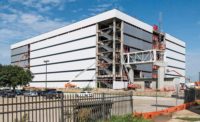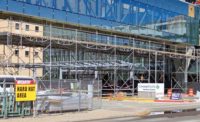Jones says Tulane and its community liaison work closely with neighborhood groups to resolve issues on the project and serve as the go-between with Woodward. The contractors and school meet biweekly to address not only construction updates but also current issues with the neighborhood.
"It has been tough [on Woodward]. There's no secret that it's a constrained site … and they have [had] to adjust days and hours of work," she says.
Overtime, prefab, scheduling
Initial delays and the approaching football season put more pressure on the contractor to get the job done in a shorter time frame than initially planned. Woodward addressed the challenge by tightening its scheduling, using more overtime and incorporating some prefab design. Because the university was still receiving donations after the groundbreaking, there were a number of changes and additions during construction.
Delays in starting the project, including changes in design based on input from neighbors, raised the project cost by about $3 million, Jones says.
Because of space and time limitations, Woodward made a great effort to sequence the work as efficiently as possible. With little laydown space, crews utilized the field itself and built the stadium around it. They also left out a small section in the stadium wall to accommodate large machinery. Woodward had to synchronize scheduling work precisely with material arrivals to minimize clutter.
"We had to do a lot of up-front planning on how we were going to get those materials in and how we were going to be able to work three or four steel erection crews simultaneously," he says.
Some parts of the stadium also tied into existing office buildings, requiring crews to work closely with the university to schedule closures. Stormwater drainage was another important issue. One of the first parts of the project entailed constructing a 60,000-cu-ft stormwater detention system just outside the stadium. All the drainage from the stadium and surrounding campus is piped into an underground holding area, then pumped into the city's main system.
"We put in the stormwater detention system, then built the practice field on top. It helps drain not only the field but also this side of the campus," says Flower.
At peak construction, up to 200 workers were on site. Woodward is using more than two dozen subcontractors on the project, including Durr Heavy Construction and MCC Group. Georgia-based UBU Sports is installing the field. UBU CEO Mark Nicholls says Tulane took an extraordinary amount of time reviewing the field layout and finding the right product and design. They ultimately selected the UBU Speed Series S5-M, a synthetic turf engineered with Harmony silt-film fiber and a 70% rubber/30% sand-infill ratio.
Nicholls says Woodward was instructed to provide the appropriate base and slope for the field. The area required enough drainage to handle a 100-year storm and meet certain specs for compactability and planarity. Turf installation, which started in mid-July, typically takes 21 days from start to finish, says Nicholls. The turf is manufactured at the firm's facility in Dalton, Ga., trucked to the site, then rolled out in segments and sewn into place. The finished field will have 2.5 in. of grass-plate fiber with 1.75 in. of rubber infill.
"There is a significant amount of craftsmanship involved in building one of these fields. While many people can build a run-of-the-mill high-school field, this is a higher level," he says.








